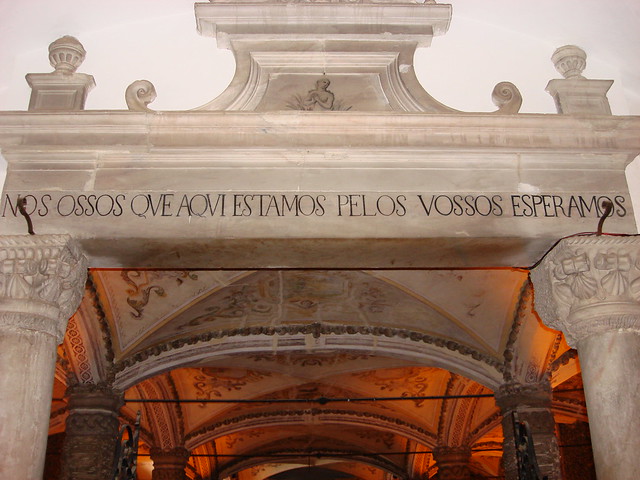Capela dos Ossos
Capela
dos Ossos (or in english The Chapel of Bones) is located next to the Church of
St. Francis in the medieval Portuguese town of Évora. The 16th century chapel
is a large room that gets its name because the interior walls are covered and
decorated with human skulls and bones.
The decision to use human bones as building
material for a church is certainly an unusual one, but there’s a story to
justify it. It seems that in the 16th century, Évora had about 43
cemeteries that took up way too much land. When the decision was made to
destroy some of these cemeteries, the corpses of 5,000 monks were exhumed in an
effort to save their souls from condemnation. It was decided that the remains
of these monks would be relocated to the Capela dos Ossos. However, the
existing monks soon realized that it might be a better idea to put these bones
on display, rather than behind closed doors. These monks were concerned about
the societal values of the wealthy town of Évora. So they set about
creating a place for meditation, a place where the undeniable reminder of death
would help people transcend the material world.
This is clearly shown in the famous warning at the entrance: Nós
ossos que aqui estamos pelos vossos esperamos (“We, the bones that are
here, await yours.").
 Interestingly, the bones of the monks who
assembled the chapel are not on display - they are kept in a small white coffin
in the chapel.
Interestingly, the bones of the monks who
assembled the chapel are not on display - they are kept in a small white coffin
in the chapel.
(One
of two poems that are in the Chapel)
Aonde vais, caminhante, acelerado? Where are you going in such a
hurry traveler?Pára...não prossigas mais avante; Stop … do not proceed;
Negócio, não tens mais importante, You have no greater concern,
Do que este, à tua vista apresentado. Than this one: that on which you focus your sight.
Recorda quantos desta vida têm passado, Recall how many have passed from this world,
Reflecte em que terás fim semelhante, Reflect on your similar end,
Que para meditar causa é bastante There is good reason to reflect
Terem todos mais nisto parado. If only all did the same.
Pondera, que influido d'essa sorte, Ponder, you so influenced by fate,
Entre negociações do mundo tantas, Among all the many concerns of the world,
Tão pouco consideras na morte; So little do you reflect on death;
Porém, se os olhos aqui levantas, If by chance you glance at this place,
Pára...porque em negócio deste porte, Stop … for the sake of your journey,
Quanto mais tu parares, mais adiantas. The more you pause, the further on your journey you will be.
(por Padre António da Ascenção) ( by Fr. António da
Ascenção (translation by Fr. Carlos A. Martins, CC)
Capela dos Ossos
Capela
dos Ossos (lietuviškai Kaulų koplyčia) yra
karališkos Šv. Pranciškaus bažnyčios dalis, viename iš Portugalijos
miestų - Evoroje. XVI amžiaus koplyčia yra gan didelė patalpa, kurios viduje
sienos ir kolonos yra padengtos ir papuoštos žmonių kaukolėmis ir kaulais, iš
kur ir kilo koplyčios pavadinimas.
Sprendimas naudoti žmogaus kaulus kaip statybinę
medžiagą bažnyčiai, yra tikrai neįprastas pasirinkimas, tačiau istorija
paaiškina šį keistą reiškinį. Iki XVI amžiaus Evoros apylinkėse buvo net 43
kapinės, kurios užėmė vertingą žemę. . Kai buvo priimtas
sprendimas sunaikinti dalį kapinių, 5000 vienuolių kūnų buvo iškasti.
Nenorėdami pasmerkti ten palaidotų žmonių sielų, vienuoliai nusprendė pastatyti
koplyčią ir į ją perkelti žmonių kaulus norint išgelbėti jų sielas nuo
pasmerkimo. Buvo nuspręsta, kad šių vienuolių palaikai bus perkelti į Capela dos Ossos. Tačiau tuometiniai
vienuoliai greitai suprato, kad geriau būtų padaryti šiuos kaulus viešai
matomus, o ne laikyti juos už uždarų durų. Užuot palaidoję kaulus, vienuoliai,
kurie buvo labai susirūpinę to meto visuomenės vertybėmis, nusprendė juos
pakabinti viešai, manydami taip sukurti garsiam ir turtingam Evoros miestui
naudingą vietą, kur žmonės galėtų susirinkti medituoti ir, neginčijamos mirties
akivaizdoje, suvoktų materialių dalykų laikinumą. Apie tai skelbia
provokuojantis užrašas virš įėjimo durų į bažnyčią "Mes, - čia esantys
kaulai, laukiame jūsų kaulų".
Įdomu
tai, kad vienuolių , kurie įkūrė šią koplyčią, kaulai, ilsisi atskirai nuo visų kitų - jie laikomi nedideliame baltame karste.
Be to, tarp visų šių kaulų, yra du lavonai, kabantys
ant sienos, šalia kryžiaus. Jų tapatybės yra nežinomos, tačiau apie juos
sklando daug legendų: viena iš populiariausių istorijų pasakoja, kad tai yra
neištikimas vyras su savo sūnumi, kuriuos prakeikė pavydi žmona.




Sem comentários:
Enviar um comentário